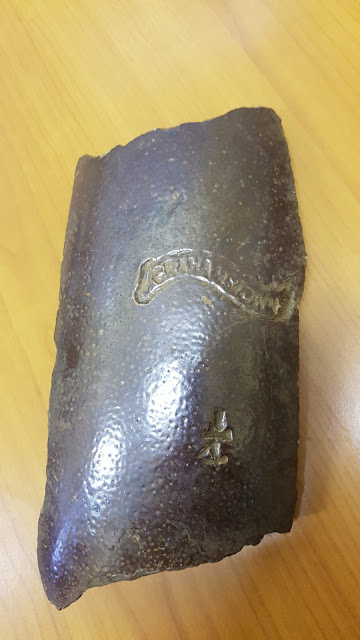A little piece of Grahamstown right here at Jeppe Boys
At first I didn't want to blog about this shard that I found on Collard's Folly. In the end I just want to share all that I've learned. I was once told that I am a wealth of useless information ....
Here we go,
Well,.....this is the largest and heaviest shard that I have ever found. Of course I had to pick it up and it is currently on my office windowsill.
This huge salt-glazed hunk of pottery has a cursive name stamped into the clay "GRAHAMSTOWN 1/4". This was an interesting find.
Initially I thought that it was a piece of a salt glazed stoneware inkpot.
The boys at Jeppe did write with pens dipped in ink for many years. A master stoneware inkpot was used by the teacher to fill up individual learner inkwell's that fit snugly into little round holes in wooden desks.
I showed the shard to Mrs Acton and she set me right.. It is in fact a piece of vintage sewage pipe made in Grahamstown.. (I did sanitise my hands after that conversation😁).
They definitely don't make things like they used to.
I did some research and found that Grahamstown is well known for awesome clay deposits.
Grahamstown has the largest known deposits of good quality kaolin in South Africa. But the abundance of this useful white clay isn’t benefitting the community. If processing plants can be opened in Grahamstown, kaolin mining could help alleviate unemployment.
From 1990 most of the kaolin processing plants were closed down. At the moment Makana is mining 27% of South Africa’s kaolin and before 1990 it constituted 55%.
It is one of the top seven industrial minerals and has prospects for providing opportunities and economic growth in Grahamstown.
Today kaolin mining is limited to mining in Grahamstown and quarrying which is restricted to only five mines.
These are AM Moss, East Cape Quarries, Strowan mining, Crousday and Makana Brick and Tile. Kaolin is extracted through open cast mining methods.
This type of mining is not labour intensive therefore an average of ten full time workers is sufficient to do the work.
Kaolin is a fine white clay produced by the decomposition of a group of rockforming minerals called feldspars.
It is used in the production of tiles, cosmetics, sanitary ware, tableware, paper, paint, rubber and pharmaceutical products.
Discovered by accident
The salt glaze technique was discovered in about 1680 by a servant. There was an earthen vessel on the fire with brine in it to cure salt pork. While the servant was away the brine boiled over, the pot became red hot, and the sides were found to be glazed.
This piece of pottery could have been sold right here in Johannesburg. Below is a very old advertisement I found.
Sources:









No comments:
Post a Comment